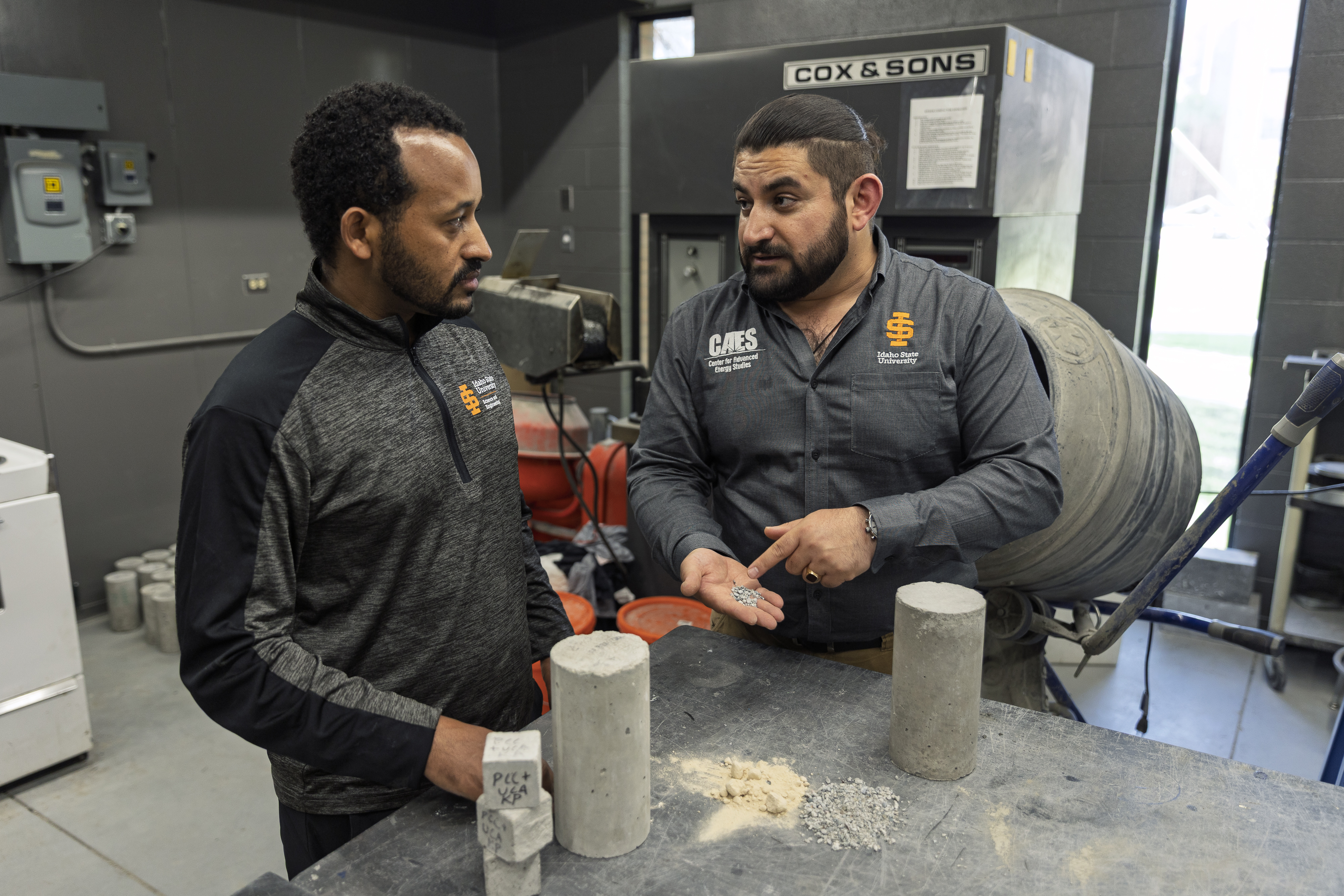Sweetcrete: ISU Researchers Looking to Take Innovative Concrete Blend from Lab to the Field
June 9, 2025

A team of researchers spanning the fields of civil engineering, materials science, and chemistry at Idaho State University is taking the next steps in optimizing a mix of concrete that’s sweeter to the environment.
Led by principal investigator Tadesse Wakjira, a researcher in the civil and environmental engineering department at ISU and the Center for Advanced Energy Studies, the project will see Wakjira and his colleagues at ISU, along with industry partners, expand on the results of a study published in 2023. The 2023 report detailed the findings of ISU researcher and former masters student Kabiraj Phuyal, led by Mustafa Mashal, professor of civil engineering, where they developed an innovative blend of concrete that swapped some of the cement for precipitated calcium carbonate (PCC), a waste product of turning sugar beets into refined sugar, and included upcycled concrete aggregate–pieces of previously used concrete–from demolished concrete structures.
.jpg)
They’ll first look to improve the concrete blend–dubbed Sweetcrete–by testing the feasibility of replacing the fresh, drinkable water in the mix with treated municipal, agricultural, and industrial wastewater.
“In Idaho, wastewater isn't just waste; it’s an opportunity,” said Wakjira. “We plan to utilize wastewater in concrete because it conserves freshwater, reduces costs for local businesses, and converts an environmental challenge into a market-ready solution.”
Next, they’ll use artificial intelligence and machine learning tools to optimize the concrete mix for practical applications, cost efficiency, and strength.
“Artificial intelligence and machine learning can help us quickly find the best concrete recipes, faster and more accurately than traditional trial-and-error methods,” explained Wakjria. “These technologies scan through thousands of possible combinations in seconds, saving time and money.”
For the third part of the project, they plan to take the product out of ISU labs and into field testing with the help of industry partners such as the Idaho Transportation Department, Amalgamated Sugar Company, Oldcastle Infrastructure, and Colliers Portneuf Valley.
“With rising infrastructure costs and the supply of cement being harder to come by, the Idaho Transportation Department is looking for new products to use to provide taxpayers and the traveling public with the best infrastructure possible,” said Zak Johnson, engineering manager with ITD.
The precipitated calcium carbonate for the Sweetcrete will be sourced from Amalgamated Sugar Company. Amalgamated Sugar Company processes over seven million tons of sugar beets by its grower-owners, producing more than 500,000 tons of precipitated calcium carbonate each year, according to the company.
“Amalgamated Sugar actively seeks commercial uses for PCC in lieu of disposing of it as waste,” said Brian Roberson, director of feed products. “Success of this project could transform an agricultural byproduct currently treated as a liability and create an opportunity.”
Oldcastle Infrastructure is one of the precast concrete partners collaborating on the project. Precast concrete components are cast off-site in controlled environments and transported to the construction site for final assembly. Oldcastle plans to help researchers by identifying potential precast test applications for precast Sweetcrete.
“We are very excited to provide support to ISU,” said Troy Banks, regional engineering manager with Oldcastle Infrastructure. “This research with ISU is fully aligned with our long-term goals.”
Along with ITD, researchers are working with Colliers Portneuf Valley to identify other potential projects to test the Sweetcrete formulation.
“It is ever so more important, now more than ever before, to meet the demands of the end user of our developments,” said Don Zebe, partner at Colliers Portneuf Valley. “The end users of these developments want to ensure that the facilities they are occupying will contribute to reducing construction costs and rents.”
In the fourth part of the research, the team will create a user-friendly software tool that enables engineers, contractors, and other decision-makers on a construction project to easily obtain a project-specific mix of Sweetcrete.
"When we combine AI with multi-objective optimization algorithms—tools that let us balance cost, strength, durability, and environmental impact at the same time—we get concrete that's perfectly suited to each project," said Wakjira. "This means better, cheaper concrete that's ready for commercial use, helping Idaho build stronger roads, safer buildings, and a healthier economy."
Funding for the project is being provided by a $550,000 grant from the Idaho State Board of Education’s Higher Education Research Council and its Idaho Global Entrepreneurial Mission program. The IGEM program provides “seed funding for strengthening Idaho’s future by strategically investing in the development of expertise, products, and services which result in state economic growth.” Co-principal investigators on the project are Mustafa Mashal, Kavita Sharma, James Mahar, Jared Cantrell, Mahesh Acharya, and Kunal Mondal from Idaho State University.
“We take pride in applied research that will benefit Idaho and result in economic development. Sweetcrete is a great example of our research efforts at Idaho State University in collaboration with our industry champions,” said Mustafa
Mashal, professor of civil engineering and lead inventor of Sweetcrete. “I have full confidence that Dr. Tadesse Wakjira and the research team will deliver a practical solution here that will benefit ISU research, industry and Idahoans for many years to come.”
“This research will generate valuable intellectual property that will result in new revenue streams for both higher education and agriculture,” said Marty Blair, vice president for research and economic development. “This transfer will result in the development of new products and techniques that will lead to higher-paying jobs and will build a strong economic foundation for Idaho.”
“Ultimately, this project aims to position Idaho as a leader in low-carbon, resource-efficient construction by leveraging emerging technologies such as AI, incorporating wastewater and agricultural byproducts into concrete production, diverting significant waste from landfills, and strengthening the state’s economic resilience,” said Wakjira.
For more information on ISU’s Department of Civil and Environmental Engineering, visit isu.edu/cee. More on some of the other research happening at ISU can be found at isu.edu/research/.
Prospective students can schedule a campus tour at isu.edu/visit.
Categories:
